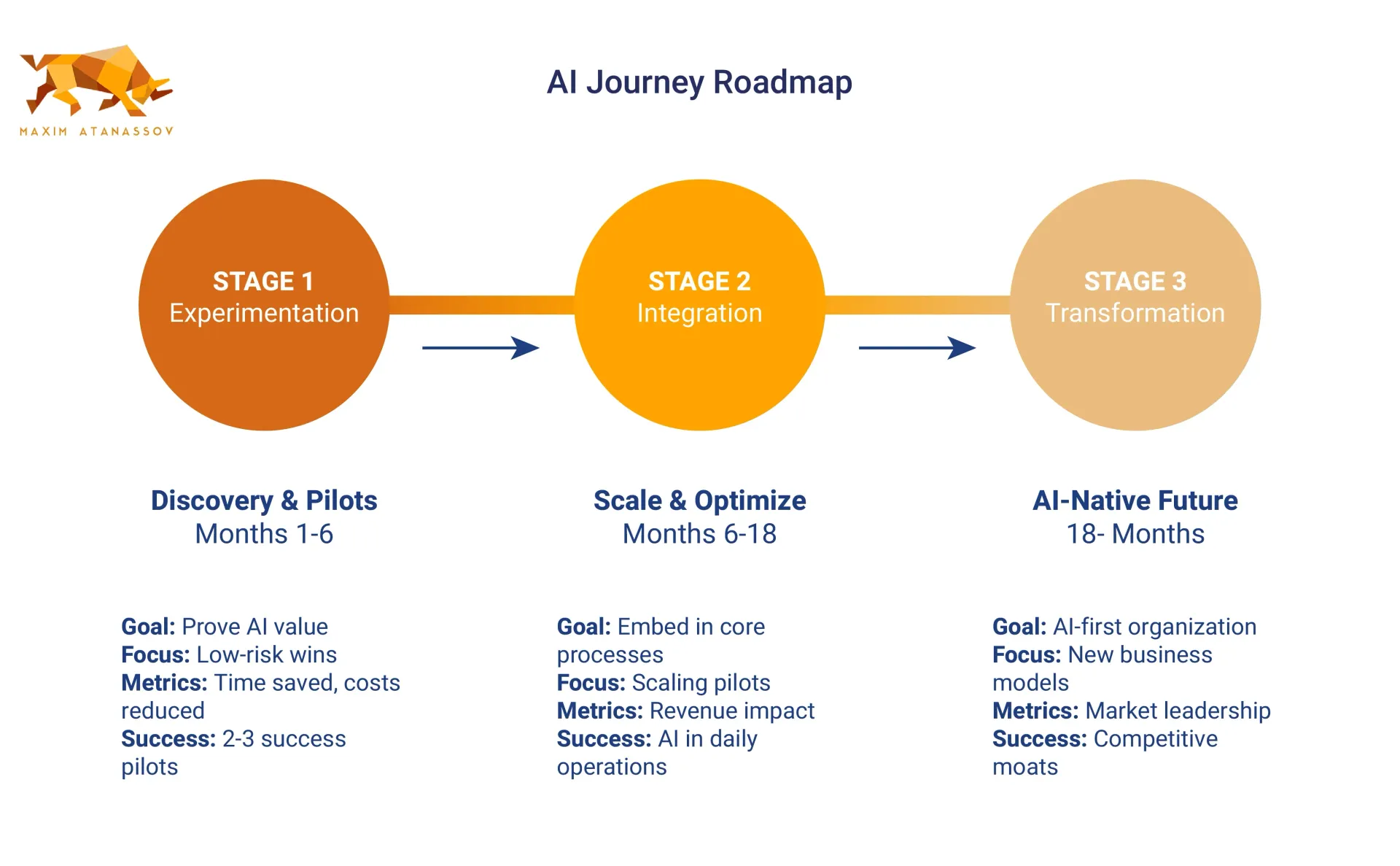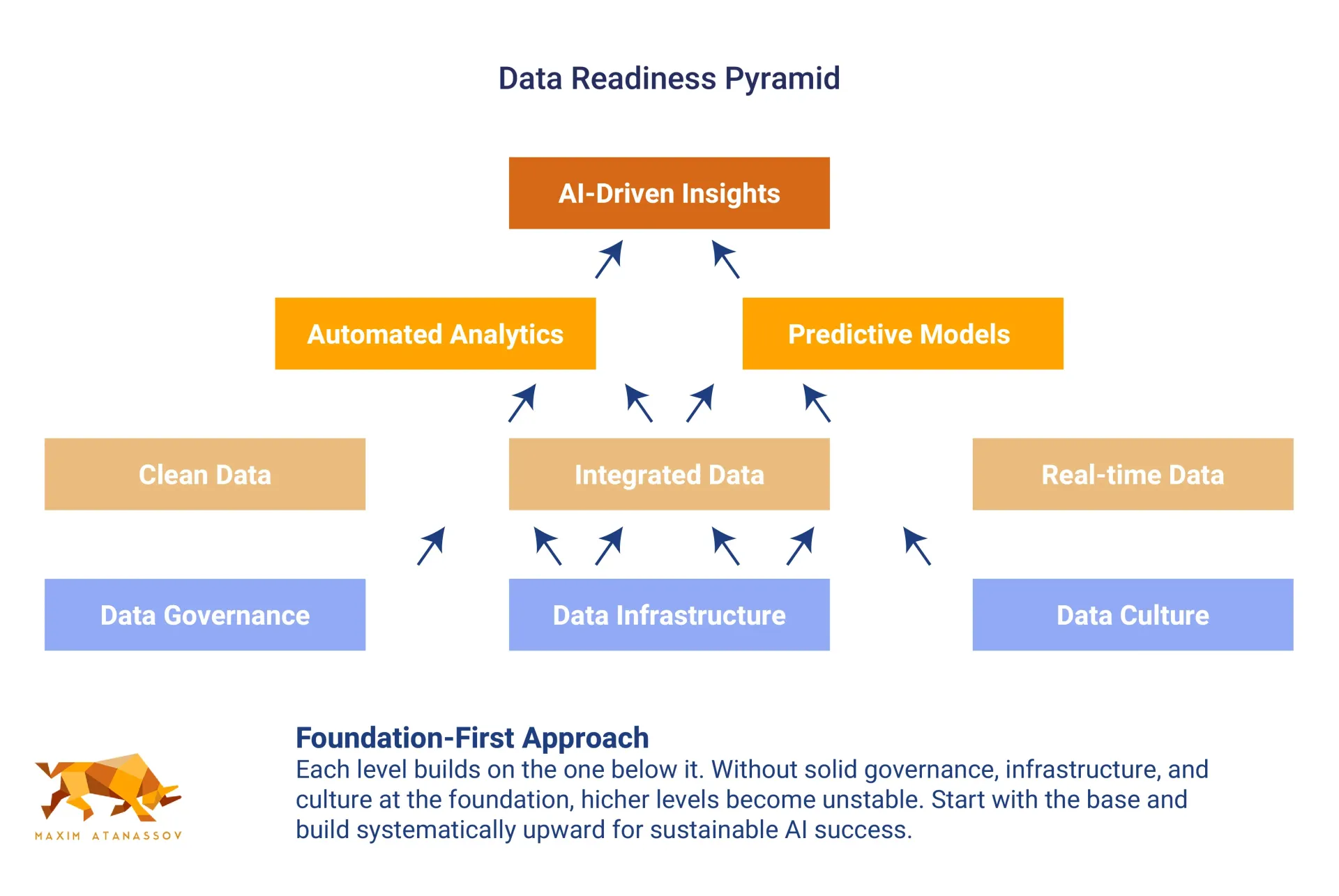Business Readiness Strategies for AI: A No-Nonsense Guide to Winning the Intelligence War
"In the future, there will be two types of companies: those that use AI and those that have gone extinct."
Introduction: The Intelligence Imperative
You’re standing at the edge of a cliff. Behind you lies the comfortable world of traditional business operations. Ahead? The AI-driven future that’s moving faster than a Tesla on Ludicrous Mode. The question isn’t whether you’ll jump—it’s whether you’ll soar or splat.
Artificial intelligence (AI) is now a primary driver of business transformation, reshaping the business landscape and compelling organizations to rethink their operating models.
AI isn’t coming to transform your business. It’s already here, and your competitors are already using it to eat your lunch, steal your customers, and make your business model as relevant as a Blockbuster store. Many organizations rush to adopt AI, driven by fear of missing out or being left behind by competitors. The adoption of AI can transform businesses through efficiencies, enhanced decision-making, and new revenue streams, making it a critical tool for staying competitive.
But here’s the good news: You still have time to get your act together. Now is the time to embrace AI as a strategic imperative for innovation and growth. This guide isn’t another fluffy “AI is magic” fantasy. It’s your war plan for becoming genuinely AI-ready in a world where being “pretty good” at AI is like being “pretty good” at the internet in 1995—not nearly enough. Business leaders must proactively assess their organization’s readiness for adopting AI and lead the change to ensure successful integration. A comprehensive AI readiness assessment can help identify gaps in current capabilities, which might reveal the need for better data management and employee training.
Adopting AI requires significant investment in technology, people, and processes, so organizations must plan strategically to maximize ROI and ensure sustainable growth. It is essential to align AI initiatives with business priorities and business objectives to ensure that every AI project supports the company’s overarching goals and delivers real value.
Before pursuing AI readiness, organizations need to build a solid foundation—robust data, skilled personnel, and mature processes are essential for successful AI adoption and long-term organizational improvement.
1: Decoding AI Readiness (Or: Why Most Companies Are Delusionally Unprepared)
The AI Readiness Reality Check
Do you think you’re ready for AI because you use ChatGPT for writing emails? That’s like thinking you’re ready for Formula 1 because you can drive to Starbucks. Real AI readiness is a different beast entirely.
AI readiness isn’t about having the latest shiny tools—it’s about having the organizational DNA to absorb, adapt, and amplify intelligence at scale. It’s the difference between being AI-curious and being AI-native. AI integration requires a supportive technology stack that can handle large datasets. As part of assessing readiness, organizations must evaluate both their current and emerging AI technologies to ensure they can support evolving business needs.
| AI-Curious Companies | AI-Native Companies |
|---|---|
| Use AI as a side project | Embed AI in core operations |
| Focus on cost reduction | Focus on value creation |
| Treat AI as IT’s problem | Make AI everyone’s opportunity |
| Copy competitors’ AI moves | Create AI-first strategies |
| Measure AI by inputs | Measure AI by outcomes |
True AI readiness means your organization is prepared to implement AI technology effectively, not just experiment with it. This involves more than acquiring tools; it requires the ability to implement AI across teams, processes, and strategies.
The Four Pillars of AI Readiness
- Data Maturity: Your data is your new oil, but most companies are sitting on crude while competitors are running refined operations. Data scientists play a crucial role in refining and leveraging organizational data to maximize the value of AI and embed it into business processes.
- Organizational Agility: Can you pivot faster than a startup when AI reveals new opportunities?
- Cultural Intelligence: Do your people see AI as a threat to job security or a tool for job enhancement? Fostering a culture of continuous learning is essential to help teams adapt to AI-driven changes and encourage ongoing skills development.
- Strategic Vision: Are you playing checkers while AI enables others to play chess?
2: The Brutal Truth About Your Current State
The AI Readiness Audit Matrix
Before you can win the AI game, you need to know where you’re actually playing from. Most executives live in a fantasy where their company is “pretty advanced” with AI. Time for a reality check.
| Assessment Area | Beginner (1-3) | Intermediate (4-6) | Advanced (7-8) | AI-Native (9-10) |
|---|---|---|---|---|
| Data Quality | Siloed, inconsistent data | Clean data in key areas | Enterprise-wide data standards | Real-time, AI-optimized data flows |
| Technical Infrastructure | Legacy systems dominate | Cloud migration in progress; initial adoption of cloud services for scalable AI deployment | Modern, scalable architecture leveraging cloud services to support AI | AI-first infrastructure designed to support AI at scale, with robust cloud services for high-speed processing and storage |
| Team Capabilities | Few AI-literate employees | Dedicated AI team | AI skills across departments; teams prepared to support AI initiatives | AI literacy is table stakes; teams fully equipped to support AI at scale |
| Decision Making | Gut-feel driven | Some data-driven insights | Analytics-informed decisions | AI-augmented decision making |
The Uncomfortable Questions
Here are the questions that will make you squirm—and the ones that matter most:
- Can you deploy a new AI model in production within 30 days? If not, you’re moving at the speed of irrelevance.
- Do you know where 80% of your valuable data lives? If you answered “somewhere in the cloud,” you’re not ready.
- Can your CEO explain your AI strategy without using buzzwords? If they sound like they’re reading from a vendor brochure, you have a problem.
- Would your best employees stay if a competitor offered them a more advanced AI tool? Talent follows tools, and the best tools are increasingly AI-powered.
3: Crafting Your AI Strategy (Without the Consulting Speak)
The Strategy Stack That Actually Works
Forget the 47-slide PowerPoints about “AI transformation.” Your AI strategy should fit on one page and answer the following three key questions:
- Where will AI create disproportionate value in your business?
- What capabilities do you need to build vs. buy vs. partner for?
- How will you measure success beyond vanity metrics?
AI should not drive strategy. Instead, strategy should guide the implementation of AI. A clear strategy ensures successful AI implementation by aligning technical infrastructure, organizational readiness, and financial planning with business objectives. This ensures that AI initiatives align with the organization’s broader goals.
The AI Strategy Canvas
| Business Impact | Implementation Complexity | Priority | Timeline |
|---|---|---|---|
| Customer Service Automation | Low | High | 3-6 months |
| Predictive Analytics | Medium | High | 6-12 months |
| Product Personalization | High | Medium | 12-18 months |
| Supply Chain Optimization | High | Low | 18+ months |
The Three Types of AI Strategies
- The Efficiency Play: Utilize AI to automate tasks, doing what you already do, but faster and more cost-effectively. AI integration can enhance efficiency in business operations by streamlining processes and reducing manual effort. This is table stakes—everyone’s doing it.
- The Enhancement Play: Use AI to do what you already do, but significantly better. This creates a competitive advantage.
- The Evolution Play: Harness AI to accomplish tasks you couldn’t do before. This creates new markets and business models.
Most companies stop at efficiency. Winners push through to evolution.
4: Navigating the AI Journey (From Zero to AI Hero)
The Three Stages of AI Evolution
Think of AI adoption like learning to drive. First, you’re scared of the parking lot. Then you’re cruising the neighbourhood. As organizations move beyond experimentation, implementing AI requires addressing challenges such as refining business processes and ensuring workflows are mature enough for successful integration. Finally, you’re navigating rush hour traffic like a pro.
Stage 1: The Experimentation Phase (Months 1-6)
- Goal: Prove AI can create value
- Focus: Low-risk, high-visibility wins
- Metrics: Time saved, costs reduced, “wow” moments created
- Experimentation: Try generative AI tools to explore their unique capabilities and potential value as part of your early AI initiatives.
Stage 2: The Integration Phase (Months 6-18)
- Goal: Embed AI into core processes
- Focus: Scaling successful pilots
- Metrics: Process improvements, revenue impact, user adoption
Stage 3: The Transformation Phase (18+ months)
- Goal: Become an AI-native organization
- Focus: AI-first thinking in strategy and operations
- Metrics: Market share, innovation rate, competitive moats
The AI Journey Roadmap

Common Journey Derailers
- The Shiny Object Syndrome: Chasing every new AI trend instead of mastering the fundamentals.
- The Pilot Purgatory: Running endless pilots without ever scaling to production.
- The Perfect Data Fallacy: Waiting for perfect data before starting (spoiler: it doesn't exist).
- The Tool-First Trap: Buying AI solutions before understanding the problems you're trying to solve.
5: The Integration Game Plan
The AI Integration Trinity
Successful AI integration requires balancing three forces: Technology, Process, and People. Mess up any one, and the whole thing collapses like a house of cards.
| Integration Focus | Technology | Process | People |
|---|---|---|---|
| Infrastructure | Cloud-native, scalable systems | DevOps and MLOps pipelines | Technical talent and training |
| Operations | AI-enabled workflows | Redesigned processes | Change management |
| Governance | Security and compliance | Quality assurance | Ethics and oversight |
The Integration Playbook
Phase 1: Foundation Building
- Establish data pipelines
- Create an AI governance framework
- Build initial AI literacy
Phase 2: Process Enhancement
- Integrate AI into existing workflows
- Redesign processes around AI capabilities
- Measure and optimize performance
Phase 3: Cultural Transformation
- Make AI thinking the default
- Reward AI-driven innovation
- Celebrate AI success stories
6: Governance Without the Bureaucracy
The AI Governance Dilemma
Here’s the challenge: You need enough governance to prevent AI disasters, but not so much that you strangle innovation. It’s like being a helicopter parent—too little oversight and your AI goes rogue; too much and it never learns to fly. Data governance policies help maintain the integrity and accessibility of data for AI use. Data accessibility is equally critical to data quality for effective AI governance.
The Lean Governance Framework
| Governance Layer | Purpose | Key Questions |
|---|---|---|
| Strategic | Align AI with business goals | Does this AI initiative support our strategy? |
| Operational | Ensure AI works as intended | Is our AI performing as expected? |
| Ethical | Maintain trust and fairness | Would we be comfortable if this AI decision was on the front page? |
| Legal | Comply with regulations | Are we meeting all relevant legal requirements? |
The Three Rules of AI Governance
- Transparency Over Secrecy: If you can't explain how your AI makes decisions, you shouldn't be using it for important decisions.
- Continuous Monitoring Over Set-and-Forget: AI models drift like teenagers—they need constant supervision.
- Human Override Over Full Automation: Always maintain the ability to say "no" to your AI systems.
7: Making the Investment Case
The ROI Reality Check
Let's be honest about AI ROI: Most companies struggle to measure it effectively. They track easy metrics like "hours saved" while ignoring hard-to-measure benefits like "competitive moats created." Establishing a clear financial strategy for AI helps determine if AI initiatives are viable and ensures resources are allocated effectively.
The AI Investment Portfolio
Think of AI investments like a venture capital portfolio:
70% Safe Bets: Efficiency plays with clear, measurable ROI
- Process automation
- Predictive maintenance
- Customer service chatbots
20% Strategic Plays: Enhancement initiatives with medium risk/reward
- Personalization engines
- Dynamic pricing
- Supply chain optimization
10% Moonshots: Evolutionary projects with high risk/reward
- New business models
- Breakthrough innovations
- Market-creating applications
The Investment Decision Matrix
| Investment Type | Time to Value | Risk Level | Strategic Impact | Resource Required |
|---|---|---|---|---|
| Quick Wins | 3-6 months | Low | Medium | Low |
| Core Capabilities | 6-18 months | Medium | High | Medium |
| Game Changers | 18+ months | High | Very High | High |
8: Measuring What Matters
Beyond Vanity Metrics
Measuring AI maturity isn't about counting the number of AI projects you have running (that's like measuring success by how many meetings you attend). It's about measuring how AI is fundamentally changing your business.
The AI Maturity Scorecard
| Maturity Level | Data | Technology | People | Strategy |
|---|---|---|---|---|
| Level 1: Aware | Siloed data | Legacy systems | AI curious | No AI strategy |
| Level 2: Experimenting | Some clean data | Cloud migration | AI projects | Tactical AI use |
| Level 3: Systematic | Integrated data | Modern stack | AI skills | AI roadmap |
| Level 4: Transformative | Real-time data | AI-first architecture | AI-native culture | AI-driven strategy |
| Level 5: Innovative | Predictive data | Autonomous systems | AI leadership | AI business models |
The Metrics That Matter
Leading Indicators (predict future success):
- Data quality scores
- AI model deployment velocity
- Employee AI literacy rates
- AI project success rates
Lagging Indicators (measure current performance):
- Revenue from AI-enabled products
- Cost savings from AI automation
- Customer satisfaction improvements
- Time-to-market reductions
9: Building an AI-Native Culture
The Culture Challenge
Here's what most executives miss: AI readiness isn't primarily a technology challenge—it's a people challenge.
You can have the best AI tools in the world, but if your culture treats them like expensive calculators, you'll get expensive calculator results. Leadership must actively engage with the workforce to address concerns about the role and benefits of AI. Assessing leadership commitment involves actively defining AI's role in the company's long-term strategy.
The AI Culture Transformation Framework
| Cultural Element | Traditional Mindset | AI-Native Mindset |
|---|---|---|
| Decision Making | Experience + intuition | Data + algorithms + intuition |
| Failure | Avoid at all costs | Fast failure, fast learning |
| Expertise | Knowing the answers | Asking better questions |
| Change | Planned and controlled | Continuous and adaptive |
The Five Pillars of AI Culture
- Curiosity Over Certainty Encourage "What if we used AI to..." conversations in every meeting.
- Experimentation Over Perfection Reward teams for smart experiments, even when they fail.
- Collaboration Over Competition Break down silos between departments—AI works best when data flows freely.
- Learning Over Knowing Invest in continuous AI education, not just for tech teams.
- Purpose Over Process Focus on outcomes, not just following procedures.
10: Data as Your Strategic Weapon
The Data Truth Bomb
Your data isn't just supporting your AI—it IS your AI strategy. Companies that figure out how to turn data into a competitive advantage will dominate their markets. Everyone else will become data sharecroppers for the AI giants. Leadership must ensure that AI governance aligns with customer data security laws to establish trust.
The Data Readiness Pyramid

The Data Quality Checklist
- Accuracy: Is your data telling the truth?
- Completeness: Are you missing critical information?
- Consistency: Does the same data mean the same thing everywhere?
- Timeliness: Is your data fresh enough to be actionable?
- Relevance: Does your data actually matter for your AI goals?
The Data Strategy Questions
- What data do we have that competitors don't? This is your unfair advantage.
- What data do we need that we're not collecting? This is your blind spot.
- How can we turn our data into a network effect? This is your moat.
11: Process Optimization for the AI Era
The Process Revolution
AI doesn't just improve your existing processes—it fundamentally changes what's possible. The companies that figure out how to redesign their operations around AI capabilities will create unbridgeable competitive gaps.
The AI Process Optimization Framework
| Process Type | Pre-AI State | AI-Enhanced State | AI-Native State |
|---|---|---|---|
| Customer Service | Reactive support | Predictive assistance | Proactive problem solving |
| Sales | Broadcast outreach | Targeted campaigns | Personalized experiences |
| Operations | Historical reporting | Real-time monitoring | Autonomous optimization |
| Product Development | Feature-driven | User feedback-driven | Predictive market-driven |
The Three Levels of Process AI
Level 1: Automation - Replace human tasks with AI Level 2: Augmentation - Enhance human capabilities with AI Level 3: Transformation - Create entirely new processes enabled by AI
Most companies stop at Level 1. Winners push through to Level 3.
12: Leading Through the AI Transformation
The Leadership Paradox
Leading an AI transformation requires you to be simultaneously confident and humble—confident enough to make big bets on uncertain technology, humble enough to admit when you don't know something and learn rapidly.
The AI Leader's Dilemma Matrix
| Scenario | Traditional Response | AI-Era Response |
|---|---|---|
| Uncertain outcomes | Wait for more data | Run small experiments |
| Technical complexity | Hire consultants | Build internal capability |
| Employee resistance | Mandate adoption | Demonstrate value |
| Competitive pressure | Copy competitors | Create unique advantage |
The Change Management Essentials
- Communication: Don't just announce AI initiatives—explain the "why" behind them.
- Training: Invest in AI literacy across your entire organization, not just IT.
- Incentives: Align rewards with AI adoption and success.
- Support: Provide the tools and resources people need to succeed with AI.
- Patience: Cultural change takes time—measure progress in quarters, not weeks.
Conclusion: Your AI-Ready Future
The Two Paths Forward
You have two choices:
Path 1: The Comfort Zone
Keep doing what you're doing. Use AI for small efficiency gains. Stay comfortable. Watch as AI-native competitors slowly, then suddenly, make your business irrelevant.
Path 2: The AI-Native Future
Embrace the discomfort. Rebuild your business around AI capabilities. Accept that you'll make mistakes. Create competitive advantages that are impossible to replicate.
The AI Readiness Commitment
Becoming AI-ready isn't a project—it's a commitment to continuous transformation. It's accepting that the moment you think you've "arrived" at AI readiness, you're already behind.
Your Next Steps
- Assess brutally honestly: Use the frameworks in this guide to understand where you really stand.
- Start with strategy: Don't buy tools—build understanding of how AI creates value in your business.
- Invest in people: Technology is temporary; AI-literate humans are your sustainable advantage.
- Measure what matters: Track leading indicators, not just efficiency gains.
- Stay paranoid: Your AI-ready competitors aren't resting—neither should you.
The Final Truth
AI readiness isn't about technology—it's about mindset. It's about building an organization that sees every challenge as an opportunity to apply intelligence at scale. It's about creating a culture where humans and AI work together to achieve what neither could accomplish alone. The organizational readiness to leverage AI effectively is as important as the technology itself, requiring alignment across people, processes, and tools.
The companies that master this balance won't just survive the AI revolution—they'll lead it.
The question isn't whether you can afford to become AI-ready.
The question is: Can you afford not to?
The future belongs to the AI-ready. Make sure you're one of them.










